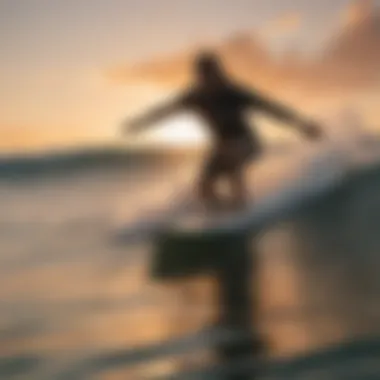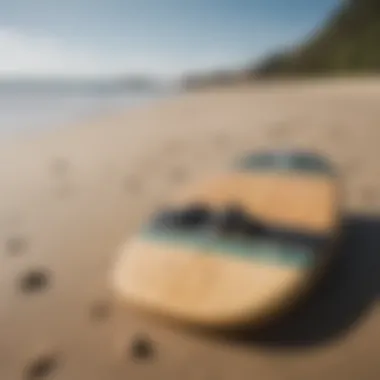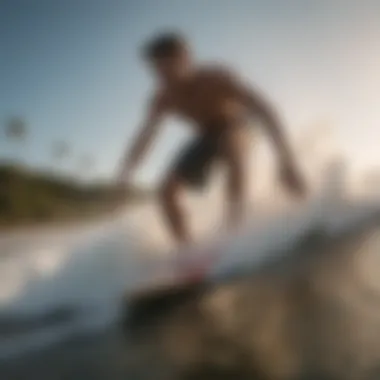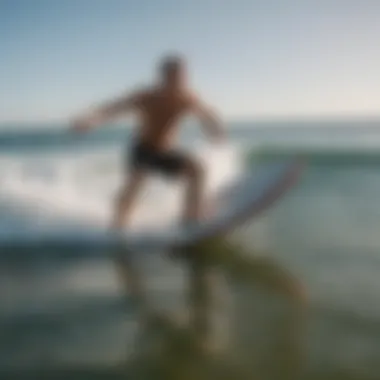Skimboarding Techniques, Gear, and Culture Explored


Intro
Skimboarding has steadily carved its place in the hearts of thrill-seekers and ocean lovers alike. Picture sandy beaches where riders glide effortlessly, chasing the fleeting surf waves. This sport, which blends elements of surfing and skateboarding, is more than just a pastime; it is a lifestyle, a community, and an art form. To fully grasp the depths of skimboarding, one must explore the techniques that shape it, the gear that’s essential for a successful ride, and the vibrant culture that fuels its growth.
Understanding skimboarding starts with appreciating its roots, emerging from coastal life and the joyous pursuit of catching waves before they break. The simplicity of the sport — running, jumping, and riding the water’s edge — belies the skill required to master it. As we embark on this exploration, we’ll uncover how both newcomers and seasoned skimboarders navigate this exhilarating world. From basic moves that let beginners find their footing, to the advanced tricks employed by seasoned pros, each element adds richness to the exhilarating culture surrounding skimboarding.
Thus, let’s dive into the essentials that drive this sport forward.
Preface to Skimboarding
Skimboarding is not just a sport; it's a lifestyle that connects enthusiasts to the sand and the sea in an exhilarating way. Understanding its nuances allows newcomers to grasp why many are drawn to it and why it holds a special place in coastal cultures. From those fresh off the beach trying to master their first ride to seasoned pros executing jaw-dropping tricks, skimboarding caters to everyone.
Understanding Skimboarding
At its core, skimboarding involves riding a board on the shoreline, often just before the tide rolls in. Unlike surfing, which primarily requires tackling waves after they’ve formed, skimboarding invites participants to glide effortlessly across the water's surface, allowing the thrill of speed to merge seamlessly with the freedom of movement. This blend of finesse and power makes it appealing for those who relish beach life.
Skinboarding is often viewed as an intersection of skating and surfing, bringing in elements from both worlds. On mushy beaches, where waves lack substance, skimboarding transforms flat beaches into a playground, enabling riders to perform simple slides or more complex stunts. Every successful session leaves riders energized, pushing them to uncover greater challenges.
"The tide may recede, but the thrill stays with us."
However, skimboarding isn't purely about the tricks and flips; it's about connecting with nature. Riders often find themselves in harmony with their environment, feeling the ebb and flow of the ocean and tasting the salty air that fills their lungs. This sport embodies a laid-back yet invigorating lifestyle, appealing to people who thrive on outdoor adventure.
The History of Skimboarding
The roots of skimboarding can be traced back to the sandy beaches of Laguna Beach, California, in the 1920s. Originally, it was a simple pastime created by surfers who wanted a way to practice balancing and sliding. Using wooden boards, they would skim atop the thin layer of water, which was a means to hone their skills before hitting the waves.
Fascination with this activity grew, and by the 1970s, skimboards began evolving in design from handmade wooden strips to precision-crafted foam boards. These technological advancements opened the door to more techniques and tricks, elevating skimboarding from a local beach pastime to a recognized sport across the globe.
With the rise of organized competitions in the late '80s, a dedicated community began forming around skimboarding. Riders pushed the boundaries of what was possible on a board, turning contests into showcases of creativity and skill. Today, events like the World Skimboarding Championship highlight the high level of talent in the sport, bringing together riders from various countries to celebrate not only the sport but also the culture behind it.
As skimboarding continues to evolve, it holds onto its roots. It remains an expression of coastal life and a testament to the passion of those who ride the waves, reminding everyone that in the world of skimboarding, every ride tells a story.
Techniques in Skimboarding
When delving into the essence of skimboarding, understanding techniques is crucial. This aspect bridges the gap between mere participation and mastering the sport. Techniques in skimboarding encompass everything from basic skills to the flamboyant maneuvers that seasoned pros perform. They’re not just technicalities; they define how one interacts with the water, the board, and the environment around them.
The joy of skimboarding stems from the thrill of gliding over the surface, and this exhilaration is grounded in technique. Each maneuver, be it a simple ride or an advanced trick, relies on a foundation built from knowledge and practice. This leads to several key benefits, such as improved balance, enhanced performance, and increased safety on the water.
Basic Skills for Beginners
For those just stepping into the world of skimboarding, mastering basic skills is essential. Start with the fundamentals—the approach and the stance. Here’s a breakdown of some foundational actions:
- Pushing Off: The initial push off the shore is vital. It sets the momentum for your ride. Focus on a smooth start; a shaky launch can throw you off balance right away.
- Finding Your Stance: Understand your foot placement. A comfortable stance is usually shoulder-width apart, with your knees slightly bent. This helps maintain balance.
- Body Weight Distribution: Move your weight forward when you want to accelerate and shift back when you wish to slow down or maintain control.
As you practice these skills, remember that patience is key. Progress may seem slow, but with persistence, the beautiful fluidity of skimboarding will be yours to enjoy.


Advanced Maneuvers
Once the basic skills are nailed down, many skimboarders yearn to elevate their game with advanced maneuvers. These tricks require a firm grasp of technique and control that can sometimes make or break a performance.
Some notable maneuvers include:
- 360 Spins: A crowd favorite. Initiate a turn and snap your board around, landing back facing the shore. It’s as much about timing as it is about control.
- Shuvits: This involves popping the board off the water, rotating it beneath you once, and landing back on it. Great for showing some flair!
- Sprays and Slides: Mastering these tricks makes you stand out. As you ride, you’ll want to kick your back foot to spray water out from under your board or slide sideways, creating eye-catching effects.
As you delve deeper into these advanced moves, ensure you practice in a safe environment. Not all spots are perfect for every maneuver, so scouting for smooth, clean sand can make a difference.
Common Mistakes to Avoid
Every sport comes with its set of pitfalls, and skimboarding is no exception. Rushing into maneuvers without proper understanding can result in slips and falls. Here are some common mistakes to sidestep:
- Poor Stance: Many beginners underestimate the importance of a stable stance. Knees should be bent but not excessively; it’s all about finding that sweet spot for balance.
- Not Using the Waves: A major error is ignoring the waves. Use them to your advantage; they can help propel you further and make transitions smoother.
- Overconfidence: It’s easy to feel invincible, especially after mastering a few tricks. Remember to remain cautious—underestimating a new maneuver can lead to injuries.
Take heed: Avoiding these common mistakes will not only enhance your performance but also improve your overall experience.
Gear and Equipment
Understanding the gear and equipment in skimboarding is critical to mastering the sport. Just like any other sporting activity, the right equipment can make or break your skimboarding experience. Not only does quality gear enhance performance, but it also ensures safety, comfort, and ultimately enjoyment on the water. Skimboarding brings unique challenges that require specific solutions; therefore, having the proper setup becomes paramount for both novices and experienced riders alike.
Types of Skimboards
When it comes to skimboards, choosing the right type sets the stage for your riding journey. Broadly speaking, skimboards can be categorized into a few key types:
- Flat Skimboards: These boards are usually wider and allow for easy gliding over thin water. They are great for beginners learning the ropes.
- Hybrid Skimboards: A good middle ground, hybrid boards often feature a combination of design elements to balance stability and speed. They can be beneficial for riders comfortable enough to try some sophisticated tricks but still value ease of use.
- Wedge Skimboards: These are thinner and designed for advanced maneuvers and tricks. They allow for more control when performing aerial stunts but require more skill and balance.
Each type offers its unique advantages, so your choice depends on your skill level and desired style of riding. A beginner seeking to learn basic skills may opt for a flat skimboard, while someone ready to dive into more complex techniques might lean towards a wedge.
Choosing the Right Skimboard for Your Style
Selecting the perfect skimboard is not merely about aesthetics; it's about alignment with your surfing style and proficiency. Here are a few considerations to keep in mind when making your decision:
- Riding Environment: If you frequent rocky beaches, you might invest in more durable boards, crafted from resin to resist impact. On the other hand, smoother sand requires a different board structure and design.
- Physical Attributes: Your weight and height play a significant role in the choice. It's generally recommended that lighter riders look for lighter boards, whereas heavier individuals might want thicker boards that can withstand their weight.
- Skill Level: As mentioned before, novices should stick with flat or hybrid boards initially. You can always polish your skills over time, and once comfortable, shift to more advanced styles.
- Personal Preference: In the end, your choice also comes down to how close you want to be with the sport. A skimboard that resonates with you aesthetically and functionally will bolster your confidence on the water.
Maintenance and Care for Skimboards
Just like any sporting gear, your skimboard deserves a good deal of TLC if you want it to last. Neglecting the care of your board can lead to diminished performance, risking both your safety and enjoyment on the water. Here are some tips for maintaining your skimboard:
- Washing: After a day at the beach, rinse your board with fresh water to remove sand and salt. This simple act prevents corrosion and material breakdown.
- Drying: Allow it to dry completely before storing it. Leaving it wet could lead to mold, which can weaken the board over time.
- Store Properly: When not in use, keep your skimboard in a cool, dry place, avoiding direct sunlight as UV rays can damage the materials.
- Inspect Regularly: Look out for any cracks or dents. Addressing these issues early can save you money in the long run and ensure your board remains in prime condition.
The bond you form with your skimboard can yield a rewarding experience, but it requires effort to keep it in top shape. Remember, a well-cared-for skimboard is not just a piece of equipment; it's your passport to countless adventures on the waves.
The Skimboarding Community


The essence of skimboarding is not solely found in the techniques or the thrill of gliding over the waves; it significantly resides in the community that surrounds the sport. The Skimboarding Community plays a crucial role in shaping the culture, sharing knowledge, and supporting those who are passionate about the activity. From local beaches to global competitions, this tightly-knit group of enthusiasts fosters an environment where experiences are exchanged, friendships are formed, and the sport continues to evolve.
In many ways, being part of the skimboarding community is akin to joining a family. Members often gather at popular spots, sharing tips, tricks, and sometimes their boards. Newcomers feel welcomed as seasoned skimboarders provide guidance in mastering basic skills or perfecting advanced maneuvers. The benefits of such a community are immense: it encourages individual growth while promoting the sport as a whole.
Skimboarding Culture and Lifestyle
The culture of skimboarding is unique, mixing elements from surfing, skateboarding, and beach life itself. It embodies a laid-back ethos, one that celebrates not just the activity but also the lifestyle surrounding it. This culture promotes respect for nature, camaraderie among practitioners, and overall enjoyment of life by the coast.
Skimboarders embody a certain freedom that comes from riding on water, often showcasing an array of creativity in their riding styles. The lifestyle goes beyond just the sport; it includes beach barbecues, shared sunsets, and meaningful connections with both locals and visitors alike.
"Skimboarding is not just a sport; it’s a way of life that celebrates the beauty of nature and the joy of connection."
Notable Skimboarding Events and Competitions
Throughout the year, numerous skimboarding events occur worldwide, gathering both amateurs and professionals. These competitions highlight the skills and creativity of participants while fostering a spirit of friendly rivalry. Events like the World Skimboarding Championship and the Skim USA events showcase intense performances and serve as an excellent opportunity for enthusiasts to meet.
Participating in these competitions offers numerous benefits:
- Skill development: Competing pushes a skimboarder to refine techniques and try new maneuvers.
- Networking: Meeting other skimboarders can lead to friendships, mentorships, and collaborations.
- Exposure: Competitions can bring visibility to rising talents, helping them gain recognition within the community.
Influential Figures in Skimboarding
Influential figures in the skimboarding world have often transcended just being athletes; they have become icons who inspire others to take up the sport. These individuals, through their unique styles and contributions, shape the perception and growth of skimboarding.
Some notable names include:
- Blair Conklin: Known for his powerful performance and innovative tricks. His tutorials and videos have inspired many newcomers.
- Mike Stewart: A pioneer in the sport who brought attention to skimboarding as a legitimate form of surfing, emphasizing its technical aspects.
- Kalama J.: Acts as an ambassador for the sport, promoting it globally and participating in various events to boost interest among youth.
These figures play a critical role in the skimboarding community, not only for their skills but also for their dedication to sharing the sport with others. Their influence helps in nurturing the next generation of skimboarders and safeguarding the culture of this exhilarating sport.
Environmental Considerations
Skimboarding is not just a thrill-seeking activity; it’s intertwined with the very ecosystems in which it thrives. Understanding the environmental considerations of skimboarding is crucial, as it provides insight into the delicate balance of coastal environments. Surfers, outdoor enthusiasts, and travel bloggers should appreciate how their favorite pastime can impact nature and how they can play a part in preserving it.
Impact of Skimboarding on Local Ecosystems
Skimboarding often occurs in sandy coastal areas, where water meets land. This relationship means that the activity can both positively and negatively affect local ecosystems. On one hand, skimboarding brings attention to these beautiful areas, encouraging conservation efforts due to increased interest from the community. On the other, if not managed properly, it can cause significant disturbance to wildlife habitats and coastal vegetation.
For instance, frequent skimboarders in a given area can lead to erosion of sand dunes, which serve as natural barriers against storms. The disturbances can affect the nesting sites of sea turtles and shorebirds, impacting their populations over time. It’s akin to a double-edged sword; while participating in the thrill, skimboarders must remain aware of their surroundings and the hidden vulnerabilities of marine life nearby.
“Every little footprint counts.”
How Skimboarding Affects Specific Elements
- Dune Health: Activities in sensitive areas can lead to erosion and the degradation of dune plants, which are essential for sediment stabilization.
- Water Quality: Increased human activity near water sources can result in litter and pollution, which find their way into marine habitats.
- Wildlife Disruption: Close proximity to nesting areas can lead to abandonment by birds and other wildlife trying to thrive in these habitats.


Sustainable Skimboarding Practices
Recognizing the environmental impact of skimboarding is the first step towards adopting sustainable practices. By changing certain behaviors and integrating ecological awareness into our skimboarding routines, enthusiasts can minimize their footprint on coastal ecosystems.
Here are some practices that can promote sustainability:
- Clean Up After Yourself: Always take trash out and keep beaches clean. Picking up even a few pieces of litter can make a considerable difference.
- Stay on Designated Paths: When accessing the beach, use paths that are already established to minimize disruption to fragile vegetation.
- Educate Others: Share knowledge about the local ecosystems and the importance of protecting them with fellow skimboarders and beachgoers.
- Volunteering for Clean-ups: Get involved in community efforts that focus on preserving coastal environments, such as local beach clean-up days.
- Responsible Gear Use: Opt for eco-friendly skimboarding gear when possible, minimizing harm to the environment.
By embracing these practices, skimboarders not only protect the environment but also ensure the longevity of their beloved sport for generations to come. Understanding and addressing these environmental considerations invites all involved in skimboarding to forge a deeper connection with the earth while riding its waves.
Travel and Location Insights for Skimboarding
When it comes to skimboarding, finding the right spot to practice is just as crucial as mastering techniques or having the right gear. Travel and location insights play a significant role in maximizing one's skimboarding experience. Factors such as the quality of sand, wave height, and the overall atmosphere of the beach can greatly influence performance and enjoyment. Some locations are renowned for their skimboarding conditions, while others may present unique challenges and considerations for both beginners and seasoned pros alike.
Notably, skimboarders often seek out coastal towns with vibrant communities; these destinations usually have established cultures surrounding skimboarding. In addition to providing access to ideal skimboarding spots, these locales often host events and competitions, creating a supportive environment for enthusiasts. That communal aspect can be motivating, fostering a sense of belonging that often enhances the overall experience.
Best Beaches for Skimboarding
When choosing a beach for skimboarding, a few key elements come into play.
- Type of Sand: Look for soft, packed sand where the water meets the shore. This is essential because softer sand can cushion falls and packed sand allows for better speed.
- Wave Conditions: Some beaches handle small waves better than others, making them suitable for various skill levels. Find locations with consistent waves that can help build confidence.
- Crowd Density: While some may enjoy the buzz of a busy beach, fewer crowds can offer a more relaxed environment for practice.
Here’s a list of some standout locations:
- Skim City Beach, California: Known for its friendly locals and consistent waves, it’s perfect for both beginners and experienced riders.
- Long Beach, New York: This bustling beach offers a blend of competitions and casual skimboarding opportunities.
- Sandy Hook, New Jersey: With ample space and safer waters, it's favored by families and budding skimboarders alike.
These beaches not only cater to the sport but also have nearby amenities such as rental shops, local eateries, and spots for relaxation after a day on the water.
Travel Tips for Skimboarders
Traveling with a skimboard can be quite an adventure, but proper planning makes it easier. Here are some primes tips:
- Choose Lightweight Gear: Consider a lightweight skimboard; it makes transport simpler, especially if public transport is part of your travel plans.
- Pack Smart: Stash necessary gear separately, along with sun protection like sunscreen and hats. Never underestimate the harshness of the sun on sandy beaches.
- Arrive at Low Tide: For the best conditions, hit the beach during low tide. It exposes sandbars that can provide suitable skimboarding terrain.
Skimboarding, much like any outdoor sport, can be affected by the local climate. It’s prudent to check such conditions beforehand. Also, connect with local skimboarding communities through platforms like reddit.com for firsthand advice about conditions and hotspots.
"Finding the right place can uplift your overall skimboarding experience – the wave might be good, but location really sets the stage for progress!"
In embracing these insights, skimboarders can significantly enhance their enjoyment and mastery of the sport, all while discovering the captivating regions of the coast.
End
The exploration of skimboarding brings us to an important juncture in understanding both the sport and its community. The future of skimboarding hinges on several pivotal elements, each contributing to its growing popularity and evolving practices. With increased beach access and a community eager to share their knowledge, newcomers are welcomed with open arms. As more people engage with the sport, awareness regarding best practices and sustainability becomes crucial. It's not just about performing tricks or gliding over water; it's about cultivating a culture that respects our environment and shared spaces.
Exploring the collective identity among skimboarders reveals a unique tapestry woven by shared experiences. The sense of camaraderie helps to foster connections that go beyond just riding waves. Skimboarding is more than a mere sport; it's a lifestyle intertwined with art, creativity, and nature. The accessibility of the sport opens doors for many, from coastal dwellers to travelers seeking adventure on sandy shores.
Interestingly, technology's role in the sport cannot be overlooked. Innovations in gear and equipment—ranging from board materials to the designs of wetsuits—are helping athletes push boundaries. The integration of social media also provides a platform for enthusiasts to showcase their skills, share tips, and perhaps most importantly, inspire others to join in the fun.
As the sport continues to grow, it will be vital for practitioners to balance enjoyment with responsibility. Preserving natural habitats and respecting others in pursuit of leisure should remain at the forefront of the skimboarding ethos.
The spirit of skimboarding lies in both the thrill of the ride and a commitment to environmental stewardship.







